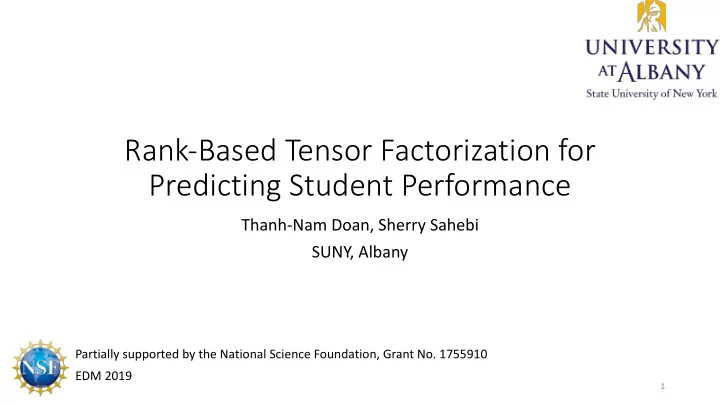

Rank-Based Tensor Factorization for Predicting Student Performance Thanh-Nam Doan, Sherry Sahebi SUNY, Albany Partially supported by the National Science Foundation, Grant No. 1755910 EDM 2019 1
Introduction • Motivation: Online learning services are popular nowadays • Coursera: 33 million registered users, 2400 courses (June 2018) • Udacity: 1.6 million users (2014) • Predicting students’ performance is an essential problem in these systems • Early detect high-risk students that may quit or fail classes • Class evaluation • Course planning activities • Learning materials recommendation to students 2
Introduction • Research question: How can we predict students’ performance • Do not require domain knowledge of the courses • Students freely select their own learning trajectory • Capture the gradual knowledge gain of students • Sometimes forget the concepts • Personalized learning rates • Contributions: We propose Rank-based Tensor Factorization (RBTF) model that considers the above requirements 3
Related Works • Needing a predefined domain model • BKT, PFA, FAST, etc • Recommender Systems - inspired • Apply recommender system techniques to educational data • Do not tailor for education data, or consider the sequence of student activities 4
Proposed model: student performance • Student score tensor Y Y is factorized into student knowledge in concept 6 7,9 and problem’s latent concept vector > ? : B 7,9,? ≈ 6 7,9 > ? + E 9 + E ? + E 7 + F A biases 5
Proposed model: student performance • Student score tensor Y Y is factorized into student knowledge in concept 6 7,9 and problem’s latent concept vector > ? : B 7,9,? ≈ 6 7,9 > ? + E 9 + E ? + E 7 + F A biases • Learning parameters is the optimization problem by minimizing G H L + regularization G H = ∑ 7,9,? A B 7,9,? − B 7,9,? 6
Proposed model: gradual knowledge gain • To capture the gradual learning, we assume that a student knowledge increases over time 6 7,9 > ? − 6 7MH,9 > ? ≥ 0 • For attempt P of student Q , the ranking of Q ’s score at P is higher than the one of Q at R with R < P 7 G L = T T T log(X( 6 7,9 > ? − 6 U,9 > ? )) UVH 9 ? 7
Proposed model: gradual knowledge gain • To capture the gradual learning, we assume that a student knowledge increases over time 6 7,9 > ? − 6 7MH,9 > ? ≥ 0 • For attempt P of student Q , the ranking of Q ’s score at P is higher than the one of Q at R with R < P 7 G L = T T T log(X( 6 7,9 > ? − 6 U,9 > ? )) UVH 9 ? • We embed the gradual knowledge gain into tensor factorization by minimizing G G = G H − ZG L • Z controls the contribution of gradual learning 8
Dataset & Experiment Setup • Canvas network data • 80% data is for training, 20% is for testing 9
Baselines & Metrics • Baselines • Feedback-Driven Tensor Factorization (FDTF): It has “hard” constraint on gradual knowledge gain [Sahebi et al., 2016] • SPARse Factor Analysis (SPARFA): It calculates the probability of students’ correct response [Lan et al., 2014] • Metrics • Root Mean Squared Error (RMSE) • Accuracy 10
Student Performance Prediction • RBTF and FDTF is better than SPARFA è the importance of considering student sequence • RBTF is better than FDTF è gradual knowledge gains should be model flexibly and allow for occasional forgetting of concepts 11
Hyper-parameter Sensitivity Analysis • Sensitivity to Z : • Z controls the trade off between having accurate estimation of student performance and constraint of knowledge increase • Larger Z : more emphasis on knowledge increase • Tune value of Z from 0 to 1 and measure RMSE of model • Result: • Z = 0.5 has the best performance in both dataset • Course 2 is more sensitive due to being more sparse 12
Hyper-parameter Sensitivity Analysis • Sensitivity to k: • k is the number of concepts • The larger k , the larger the latent space of students and questions • We tune value of k and measure RMSE • Result • Increasing k makes RBTF performs slightly worse • RBTF is robust since the the increase in error is mirror 13
Conclusion • We proposed a novel rank-based tensor factorization (RBTF) • RBTF considers the sequence of student activities • RBTF considers the gradual knowledge gains, allowing for occasional forget • RBTF does not require the prior knowledge of courses • We evaluate RBTF on the task of students’ performance prediction 14
15 Thank you Q&A ssahebi@albany.edu
Recommend
More recommend